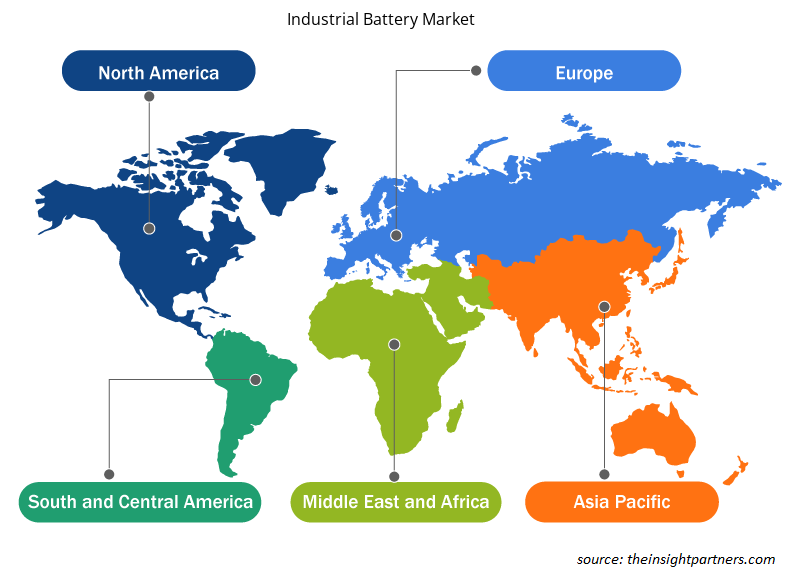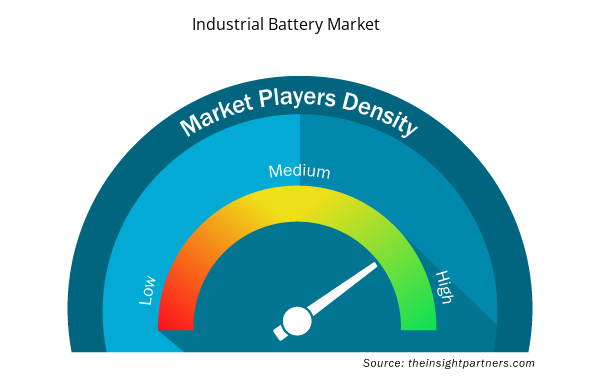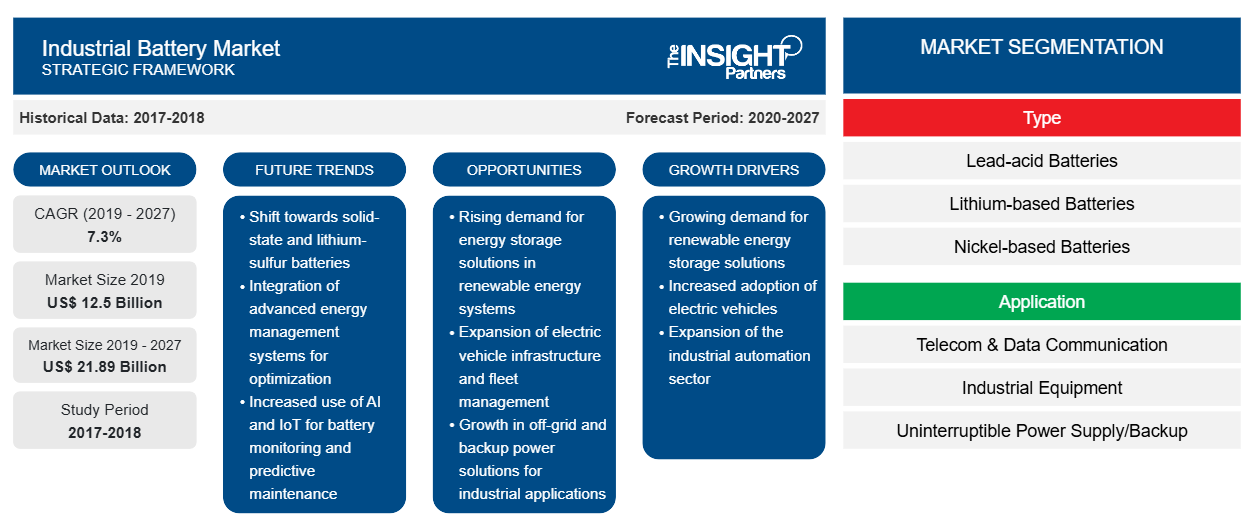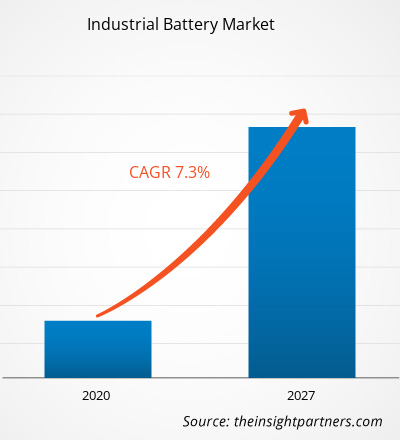El mercado de baterías industriales se valoró en US$ 12.501,9 millones en 2019 y se espera que crezca a una CAGR del 7,3% entre 2020 y 2027 para alcanzar los US$ 21.893,5 millones en 2027.
Las baterías industriales son baterías especialmente diseñadas que pueden funcionar en temperaturas industriales duras, como temperaturas extremas, más vibraciones y uso intensivo. Las baterías industriales funcionan mejor y están diseñadas para ser más potentes. En el escenario actual del mercado, las empresas están trabajando rigurosamente en el desarrollo de baterías altamente eficientes que satisfagan las diversas necesidades de baterías industriales. Se prevé que el mercado mundial de baterías industriales experimente un crecimiento impresionante durante el período de pronóstico. Se espera que la demanda de baterías a base de litio crezca significativamente durante el período de pronóstico. Se espera que la adopción de baterías de litio crezca en varias verticales debido a las ventajas que ofrece, como bajas emisiones, mayor ciclo de vida y reciclabilidad. Las empresas que operan en el mercado se están centrando en el desarrollo de nuevos productos para ganar una sólida base de clientes y lograr una participación de mercado significativa.
Los gobiernos de los países norteamericanos, como Estados Unidos, están tomando medidas continuas para mejorar la productividad de la industria manufacturera, como proporcionar las últimas tecnologías para facilitar el proceso de fabricación y aumentar el número de almacenes. Se prevé que el uso de tecnologías automatizadas en estos almacenes influya en el crecimiento del mercado de baterías industriales en Norteamérica. El aumento del gasto gubernamental conduce al desarrollo de cualquier tecnología. En la región de Norteamérica, el gasto gubernamental en actividades de avance tecnológico es bastante alto, lo que crea un clima favorable para que cualquier negocio florezca. La IoT, el Big Data y las tecnologías avanzadas han sido objeto de una gran adopción en esta región. Estas tecnologías, a su vez, alimentan los requisitos de la red mejorada, así como la demanda de baterías industriales. Pocas tecnologías emergentes en el mercado de baterías industriales son las baterías de iones de litio (Li-ion) de nueva generación, las baterías de litio-azufre, las baterías de estado sólido, las baterías de iones de aluminio, etc.
Personalice este informe según sus necesidades
Obtendrá personalización en cualquier informe, sin cargo, incluidas partes de este informe o análisis a nivel de país, paquete de datos de Excel, así como también grandes ofertas y descuentos para empresas emergentes y universidades.
- Obtenga las principales tendencias clave del mercado de este informe.Esta muestra GRATUITA incluirá análisis de datos, desde tendencias del mercado hasta estimaciones y pronósticos.
Perspectivas del mercado
Las soluciones conectadas a la red para el suministro de energía ininterrumpida impulsan la demanda de baterías industriales
Los tipos más destacados y esenciales de fuentes de energía renovable son la solar y la eólica, que se almacenan en la red. Sin embargo, la cobertura del sol por las nubes o las fluctuaciones en la corriente del viento pueden provocar variaciones en el proceso de generación de energía. Estos cambios crean la necesidad de sistemas de red flexibles para el almacenamiento de energía. Los sistemas de almacenamiento de energía de baterías industriales ayudan a los operadores de la red a ahorrar electricidad cuando la cantidad de energía supera la demanda de electricidad. Por lo tanto, la mayor adopción de estos sistemas ayuda a mejorar la confiabilidad y la flexibilidad del sistema de suministro de electricidad con respecto a las actividades de generación, transmisión y distribución. Durante la transmisión y la distribución, los sistemas de almacenamiento de energía de baterías se encargan de varios aspectos, como el aplazamiento de activos, la supresión de armónicos, el soporte de voltaje, la regulación de frecuencia y la calidad de la energía. El cambio de horario de energía eléctrica, el cambio de horario de energía renovable, la nivelación de carga base y el recorte de picos, y la consolidación de la capacidad de energías renovables son otros de los beneficios del uso de sistemas de almacenamiento de energía de baterías para soluciones conectadas a la red, que impulsan la adopción de estos sistemas, impulsando así el crecimiento del mercado de baterías industriales. Los actores del mercado están ideando nuevas soluciones de red para mantener una ventaja competitiva en el mercado de baterías industriales. Por ejemplo, Siemens ofrece SIESTORAGE, una solución de red inteligente. SIESTORAGE es capaz de superar los desafíos que surgen en las tres fases principales del suministro de energía, es decir, optimizar las conexiones a la red, proporcionar energía elástica para las redes modernas y dar soporte a los grandes consumidores de energía. Además, en julio de 2015, EDP Distribuicao ofreció la licitación de Storage InovGrid a SIESTORAGE de Siemens en Évora (Portugal). El sistema SIESTORAGE proporciona servicios como regulación de voltaje, respaldo de energía y reducción de picos en la estabilidad de la red de EDP, y replica los beneficios de las redes inteligentes para los operadores de la red.
Tipo de información
En cuanto al segmento de tipos, las baterías de plomo-ácido capturaron la mayor participación en el mercado mundial de baterías industriales. La batería de plomo-ácido tiene un bajo costo y brinda un alto rendimiento, se puede reciclar fácilmente y es simple de cargar. El uso de baterías de plomo-ácido es amplio debido a su bajo costo y larga vida útil. Sin embargo, la batería no sería adecuada para una carga alta sostenida; además, tiene una densidad de energía volumétrica relativamente menor, lo que hace que su uso sea ligeramente inviable para aplicaciones de gestión de energía; por lo tanto, se utiliza principalmente para aplicaciones de energía. Los avances de esta batería aún están en marcha, lo que podría permitir que se convierta en una opción más factible para la gestión de energía.
Información sobre aplicaciones
El mercado de baterías industriales, por aplicación, está segmentado en telecomunicaciones y comunicación de datos, equipos industriales, sistemas de alimentación ininterrumpida (UPS)/respaldo, minería, marina y otros. El segmento de equipos industriales capturó una participación dominante en el mercado global de baterías industriales. Las crecientes tendencias de la industria 4.0, como IoT, inteligencia artificial (IA), análisis de big data, comunicaciones en red, computación en la nube y tecnologías de aprendizaje automático, marcan un cambio sustancial en la forma en que las empresas trabajan y cómo se relacionan con sus clientes. Estas tecnologías en crecimiento están ofreciendo soluciones innovadoras de equipos industriales que respaldan la producción y entrega de equipos eficientes.
Las empresas suelen adoptar estrategias de fusiones y adquisiciones para expandir su presencia en todo el mundo y satisfacer la creciente demanda. Esta estrategia se observa principalmente en América del Norte y Europa. Los actores presentes en el mercado de baterías industriales adoptan la estrategia de expansión e inversión en investigación y desarrollo para ampliar la base de clientes en todo el mundo, lo que también les permite mantener su marca a nivel mundial. A continuación se enumeran algunas de las adquisiciones recientes:
2019: East Penn anunció la adquisición de una participación mayoritaria en Navitas Systems. Se espera que esta adquisición apoye la expansión de la oferta de baterías Motive Power.
2019: Saft anunció la adquisición del 100 % de las acciones de Go Electric Inc., un desarrollador con sede en EE. UU. de soluciones de resiliencia energética distribuida para microrredes y clientes comerciales e industriales.
Perspectivas regionales del mercado de baterías industriales
Los analistas de Insight Partners explicaron en detalle las tendencias y los factores regionales que influyen en el mercado de baterías industriales durante el período de pronóstico. Esta sección también analiza los segmentos y la geografía del mercado de baterías industriales en América del Norte, Europa, Asia Pacífico, Oriente Medio y África, y América del Sur y Central.

- Obtenga datos regionales específicos para el mercado de baterías industriales
Alcance del informe sobre el mercado de baterías industriales
| Atributo del informe | Detalles |
|---|---|
| Tamaño del mercado en 2019 | 12.500 millones de dólares estadounidenses |
| Tamaño del mercado en 2027 | US$ 21.89 mil millones |
| CAGR global (2019-2027) | 7,3% |
| Datos históricos | 2017-2018 |
| Período de pronóstico | 2020-2027 |
| Segmentos cubiertos | Por tipo
|
| Regiones y países cubiertos | América del norte
|
| Líderes del mercado y perfiles de empresas clave |
|
Densidad de actores del mercado de baterías industriales: comprensión de su impacto en la dinámica empresarial
El mercado de baterías industriales está creciendo rápidamente, impulsado por la creciente demanda de los usuarios finales debido a factores como la evolución de las preferencias de los consumidores, los avances tecnológicos y una mayor conciencia de los beneficios del producto. A medida que aumenta la demanda, las empresas amplían sus ofertas, innovan para satisfacer las necesidades de los consumidores y aprovechan las tendencias emergentes, lo que impulsa aún más el crecimiento del mercado.
La densidad de actores del mercado se refiere a la distribución de las empresas o firmas que operan dentro de un mercado o industria en particular. Indica cuántos competidores (actores del mercado) están presentes en un espacio de mercado determinado en relación con su tamaño o valor total de mercado.
Las principales empresas que operan en el mercado de baterías industriales son:
- Tecnologías C&D, Inc.
- Compañía manufacturera de East Penn
- Sistemas energéticos
- Industrias Exide Limitada
- Compañía General Electric
Descargo de responsabilidad : Las empresas enumeradas anteriormente no están clasificadas en ningún orden particular.

- Obtenga una descripción general de los principales actores clave del mercado de baterías industriales
Mercado de baterías industriales: por tipo
- Baterías de plomo-ácido
- Baterías a base de litio
- Baterías a base de níquel
- Otros
Mercado de baterías industriales: por aplicación
- Telecomunicaciones y comunicación de datos
- Equipos industriales
- UPS/Respaldo
- Almacenamiento de energía a nivel de red
- Minería
- Marina
- Otros
Mercado mundial de baterías industriales por región
América del norte
- A NOSOTROS
- Canadá
- México
Europa
- Francia
- Alemania
- Italia
- Reino Unido
- Rusia
- Resto de Europa
Asia Pacífico
- Porcelana
- India
- Corea del Sur
- Japón
- Australia
- Resto de Asia Pacífico
Oriente Medio y África
- Sudáfrica
- Arabia Saudita
- Emiratos Árabes Unidos
- Resto de Oriente Medio y África
Sudamerica
- Brasil
- Argentina
- Resto de Sudamérica
Perfiles de empresas
- Tecnologías C&D, Inc.
- Compañía manufacturera de East Penn
- Sistemas energéticos
- Industrias Exide Limitada
- Compañía General Electric
- GS Yuasa Internacional Ltd.
- LG Química
- Corporación Panasonic
- Robert Bosch GmbH
- Grupo Saft SA
- Análisis histórico (2 años), año base, pronóstico (7 años) con CAGR
- Análisis PEST y FODA
- Tamaño del mercado Valor/volumen: global, regional, nacional
- Industria y panorama competitivo
- Conjunto de datos de Excel



Report Coverage
Revenue forecast, Company Analysis, Industry landscape, Growth factors, and Trends

Segment Covered
This text is related
to segments covered.

Regional Scope
North America, Europe, Asia Pacific, Middle East & Africa, South & Central America

Country Scope
This text is related
to country scope.
Preguntas frecuentes
The Industrial Equipment sector is the leading industry in the market, which comprises machinery, large scale process, and construction industry plants. The growing industry 4.0 trends, such as IoT, Artificial Intelligence (AI), big data analysis, networked communications, cloud computing, and machine learning technologies, are marking a substantial change in the businesses model and the way of attracting customers. Such growing technologies are offering innovative industrial equipment solutions that support the production and delivery of efficient equipment. In order to operate a warehouse or heavy machinery, the need for material handling equipment batteries is necessary. Lithium-ion batteries are ideally used for the equipment used in various industries, such as food and beverage and tissue industries. Increasing use of industrial equipment in areas such as airport ground support, lift trucks, sweepers, and scrubbers, and automatic guided vehicles (AGV) is propelling the growth of industrial battery market.
The APAC region led the Industrial Battery market in 2019 as the factors such as the growing industrial equipment, mining, and marine industries, stringent environmental regulations, and reduced labor costs associated with battery recycling are the factors boosting the APAC industrial battery market growth.
Governments across the world are focusing on expanding the reach of digitization and promoting the utilization of several electronic devices, and have become the most important storage technology in the areas of portable and mobile applications (e.g., laptop, cell phone, electric bicycle, and electric car). Other important uses of lithium-ion batteries include storage in electrical grids. Moreover, the performance of Lithium-ion batteries (LIBs) used in grid-level energy storage systems is analyzed by service providers with regard to frequency regulation, peak shifting, integration with renewable energy sources, and power management. The increasing requirement of lithium-ion batteries in various applications is one of the major factors driving the industrial battery market.
Trends and growth analysis reports related to Manufacturing and Construction : READ MORE..
The List of companies - Industrial Battery Market
- C&D Technologies, Inc.
- East Penn Manufacturing Company
- EnerSys
- Exide Industries Limited
- General Electric Company
- GS Yuasa International Ltd.
- LG Chem
- Panasonic Corporation
- Robert Bosch GmbH
- Saft Groupe SA
The Insight Partners performs research in 4 major stages: Data Collection & Secondary Research, Primary Research, Data Analysis and Data Triangulation & Final Review.
- Data Collection and Secondary Research:
As a market research and consulting firm operating from a decade, we have published and advised several client across the globe. First step for any study will start with an assessment of currently available data and insights from existing reports. Further, historical and current market information is collected from Investor Presentations, Annual Reports, SEC Filings, etc., and other information related to company’s performance and market positioning are gathered from Paid Databases (Factiva, Hoovers, and Reuters) and various other publications available in public domain.
Several associations trade associates, technical forums, institutes, societies and organization are accessed to gain technical as well as market related insights through their publications such as research papers, blogs and press releases related to the studies are referred to get cues about the market. Further, white papers, journals, magazines, and other news articles published in last 3 years are scrutinized and analyzed to understand the current market trends.
- Primary Research:
The primarily interview analysis comprise of data obtained from industry participants interview and answers to survey questions gathered by in-house primary team.
For primary research, interviews are conducted with industry experts/CEOs/Marketing Managers/VPs/Subject Matter Experts from both demand and supply side to get a 360-degree view of the market. The primary team conducts several interviews based on the complexity of the markets to understand the various market trends and dynamics which makes research more credible and precise.
A typical research interview fulfils the following functions:
- Provides first-hand information on the market size, market trends, growth trends, competitive landscape, and outlook
- Validates and strengthens in-house secondary research findings
- Develops the analysis team’s expertise and market understanding
Primary research involves email interactions and telephone interviews for each market, category, segment, and sub-segment across geographies. The participants who typically take part in such a process include, but are not limited to:
- Industry participants: VPs, business development managers, market intelligence managers and national sales managers
- Outside experts: Valuation experts, research analysts and key opinion leaders specializing in the electronics and semiconductor industry.
Below is the breakup of our primary respondents by company, designation, and region:

Once we receive the confirmation from primary research sources or primary respondents, we finalize the base year market estimation and forecast the data as per the macroeconomic and microeconomic factors assessed during data collection.
- Data Analysis:
Once data is validated through both secondary as well as primary respondents, we finalize the market estimations by hypothesis formulation and factor analysis at regional and country level.
- Macro-Economic Factor Analysis:
We analyse macroeconomic indicators such the gross domestic product (GDP), increase in the demand for goods and services across industries, technological advancement, regional economic growth, governmental policies, the influence of COVID-19, PEST analysis, and other aspects. This analysis aids in setting benchmarks for various nations/regions and approximating market splits. Additionally, the general trend of the aforementioned components aid in determining the market's development possibilities.
- Country Level Data:
Various factors that are especially aligned to the country are taken into account to determine the market size for a certain area and country, including the presence of vendors, such as headquarters and offices, the country's GDP, demand patterns, and industry growth. To comprehend the market dynamics for the nation, a number of growth variables, inhibitors, application areas, and current market trends are researched. The aforementioned elements aid in determining the country's overall market's growth potential.
- Company Profile:
The “Table of Contents” is formulated by listing and analyzing more than 25 - 30 companies operating in the market ecosystem across geographies. However, we profile only 10 companies as a standard practice in our syndicate reports. These 10 companies comprise leading, emerging, and regional players. Nonetheless, our analysis is not restricted to the 10 listed companies, we also analyze other companies present in the market to develop a holistic view and understand the prevailing trends. The “Company Profiles” section in the report covers key facts, business description, products & services, financial information, SWOT analysis, and key developments. The financial information presented is extracted from the annual reports and official documents of the publicly listed companies. Upon collecting the information for the sections of respective companies, we verify them via various primary sources and then compile the data in respective company profiles. The company level information helps us in deriving the base number as well as in forecasting the market size.
- Developing Base Number:
Aggregation of sales statistics (2020-2022) and macro-economic factor, and other secondary and primary research insights are utilized to arrive at base number and related market shares for 2022. The data gaps are identified in this step and relevant market data is analyzed, collected from paid primary interviews or databases. On finalizing the base year market size, forecasts are developed on the basis of macro-economic, industry and market growth factors and company level analysis.
- Data Triangulation and Final Review:
The market findings and base year market size calculations are validated from supply as well as demand side. Demand side validations are based on macro-economic factor analysis and benchmarks for respective regions and countries. In case of supply side validations, revenues of major companies are estimated (in case not available) based on industry benchmark, approximate number of employees, product portfolio, and primary interviews revenues are gathered. Further revenue from target product/service segment is assessed to avoid overshooting of market statistics. In case of heavy deviations between supply and demand side values, all thes steps are repeated to achieve synchronization.
We follow an iterative model, wherein we share our research findings with Subject Matter Experts (SME’s) and Key Opinion Leaders (KOLs) until consensus view of the market is not formulated – this model negates any drastic deviation in the opinions of experts. Only validated and universally acceptable research findings are quoted in our reports.
We have important check points that we use to validate our research findings – which we call – data triangulation, where we validate the information, we generate from secondary sources with primary interviews and then we re-validate with our internal data bases and Subject matter experts. This comprehensive model enables us to deliver high quality, reliable data in shortest possible time.


 Obtenga una muestra gratuita de este informe
Obtenga una muestra gratuita de este informe